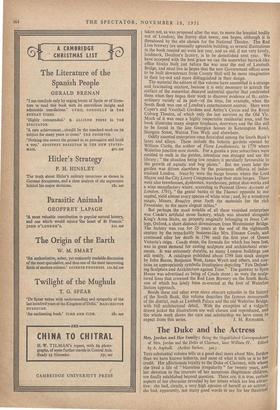Vicissitudes of South Bank
South Bank and Vauxhall. London County Council Survey of London. Vol: XXIII: Parish of St. Mary, Lambeth. Part 1. Edited by Sir Howard Roberts and Walter H. Godfrey. (London County Council. 3 os.) THE slow but continuous process of tidying up the Surrey bank of the Thames has been going on for 85 years. It began with the construction of the Albert Enibankment in 1866, took an important step forward in 1922, when County Hall was completed, and another even greater step this year with the extension of the river wall down- stream from County Hall to below Waterloo Bridge, the construction of the Royal Festival Hall and the clearance and temporary reanima- tion of the South Bank exhibition site. The latest volume of the L.C.C. Survey of London therefore appears at a moment when the character of the area it deals with is changing rapidly ; soon the traditional South Bank scenery, comprised of wharves, small streets and primitive industrial installations, which most of the pictures in the book illustrate, will have disappeared altogether.
There are more changes to come, and the role of giving continuity to the South Bank landscape is being left to a very few of the present landmarks—Lambeth Palace certai,nly, County Hall presumably, St. Thomas's Hospital it now appears (the decision has recently been
taken not, as was proposed after the war, to move the hospital bodily out of London), the Surrey shot tower, one hopes, although it is threatened by the site chosen for the National Theatre. The Red Lion brewery (an unusually agreeable building, as several illustrations in the book remind us) went last year, and an old, if not very lovely, landmark, Doulton's factory, is to be demolished next year. We have accepted with the best grace we can the somewhat barrack-like office blocks built just before the war near the end of Lambeth Bridge, and must live in hopes that the new Government offices soon to be built downstream from County Hall will be more imaginative in their lay-out and more distinguished' in their design. . The material the editors of this volume have assembled is a strange and fascinating mixture, because it is only necessary to scratch the surface of the somewhat decayed industrial quarter that confronted them when they began their work to discover evidence of thz extra- ordinary variety of its past—of the time, for example, when the South Bank was one of London's entertainment centres. Here were Cuper's and Vauxhall Gardens and Astley's Circus and the Royal Coburg Theatre, of which only the last survives as the Old Vic. Much of it was once a highly respectable residential area, and the book illustrates many elegant fireplaces, doorways and the like still to be found in the late Georgian houses in Kennington Road, Stangate Street, Walnut Tree Walk and elsewhere.
Oddly assorted enterprises once flourished among the South Bank's lanes and alleys. These include the botanic gardens opened by William Curtis, the author of Flora Londiniensis, in 1779 where Waterloo junction now stands. For a guinta a year subscribers were entitled to walk in the garden, introduce one stranger and use the library ; "the situation being low renders it peculiarly favourable to the growth of aquatic and bog plants." But ten years later the garden was driven elsewhere by the poisonous effluvia of indus- trialised London. Near-by were the barge houses where the Lord Mayor and the City Livery Companies kept their state barges. There were also brewhouses, dyehouses, warehouses, patent shot-works and a wine manufactory where, according to Pennant (Some Account of London, 1791), "the genial banks of the Thames opposite to our capital, yield almost every species of white wine ; and, by a wondrous magic, Messrs. Beaufoy pour forth the materials for the rich Frontiniac, to the more elegant tables."
But perhaps the most notable of all these vanished enterprises was Coade's artificial stone factory, which was situated alongside King's Arms Stairs, on property originally belonging to Jesus Col- lege, Oxford, a short distance downstream from Westminster Bridge. The factory was run for 25 years at the end of the eighteenth century by the remarkably business-like Mrs. Eleanor Coade, and continued after her death in 1796 until the first year of Queen Victoria's reign. Coade stone, the formula for which has been lost, was in great demand for casting sculpture and architectural orna- ments. It was extremely durable, as many London buildings can still testify. A catalogue published about 1799 lists stock designs by John Bacon, Benjamin West, James Wyatt and others, and con- tains an appropriately symbolic frontispiece depicting "Fire Defend- ing Sculpture and Architecture against Time." The gateway to Syon House was advertised as being of coade stone ; so were the sculp- tured lions that crowned the Red Lion Brewery on the South Bank, one of which has lately been re-erected at the foot of Waterloo Station approach.
Beside these and other even more obscure episodes in the history of the South Bank, this volume describes the famous monuments of the district, such as Lambeth Palace and the old Waterloo Bridge, with full architectural detail. With the exception of a vulgarly drawn jacket the illustrations are well chosen and reproduced, and the whole work shows the care and scholarship we have come to















































































 Previous page
Previous page